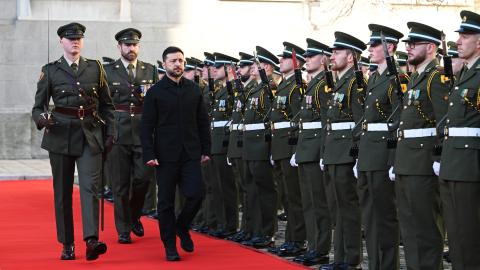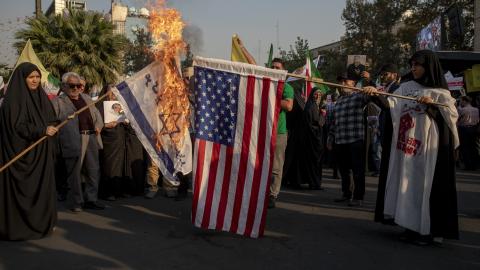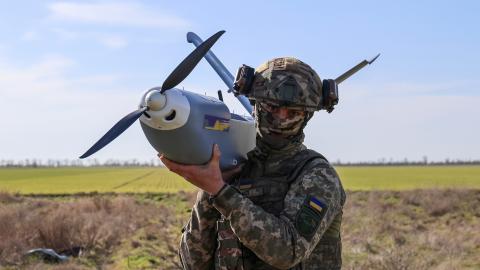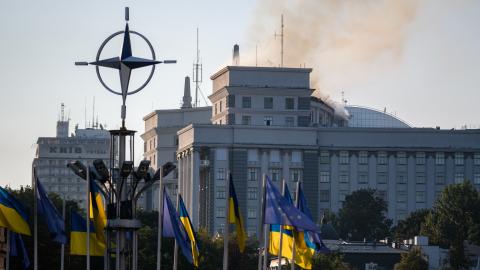Executive Summary
- Russia probes NATO defenses: Polish and allied forces responded to a “huge” number of Russian drones that entered Poland’s airspace.
- Battlefield assessment: The Russian Aerospace Forces struck symbolically important targets and population centers. Russia also allocated additional combat formations to its effort to capture Pokrovsk.
- Moscow’s indoctrination campaign: Russia has reportedly intensified its efforts to indoctrinate and militarize youths in occupied Ukraine.
- Kyiv’s new cruise missiles: The Ukrainian military hit a Russian intelligence site in occupied Crimea with Flamingo missiles.
1. Russia Probes NATO Defenses with Drone Salvo
On the night of September 9, Poland scrambled its air force to shoot down Russian drones in Polish airspace. While it is not clear how many drones Russia launched, Prime Minister Donald Tusk described the salvo as “huge.” The Polish Armed Forces’ Operational Command advised citizens to remain indoors for several hours while fighter jets conducted interceptions. Polish officials also shut down several airports, including the primary gateways for Western officials and supplies heading to Ukraine.
Multiple North Atlantic Treaty Organization members contributed assets to the air defense mission. Assisting Polish F-16s were Dutch F-35s, Italian airborne warning and control system (AWACS) aircraft, NATO aerial refueling platforms, and German Patriot air defense batteries.
The Polish government has invoked NATO’s Article 4, which requires members to convene for strategic consultations on the alliance’s mutual defense clause. Russian drones have previously hit several NATO nations. But most of these incidents were accidental, likely caused by Ukrainian electronic warfare measures. This time, open-source radar data suggests that the attack was a Russian attempt to probe NATO’s response.
As Russia and Belarus prepare for the joint military drills later this week, NATO should expect more such provocations. Moscow’s expanded Shahed drone production poses a growing threat to the alliance. In response, NATO should (1) develop a joint air defense mechanism with the Ukrainian Air Force and (2) assist with the development of Ukrainian long-range strike programs to target Russian drone and missile facilities.
2. Battlefield Assessment
Last week Russia conducted an intensive aerial campaign over Ukraine. On September 7 the Russian Aerospace Forces (VKS) hit Ukrainian population centers with more than 800 Iran-designed Shahed drones, alongside North Korean and Russian tactical ballistic missiles. In a further escalation, Russia also targeted the Ukrainian cabinet building. The previous week the VKS struck the European Union delegation’s office and the diplomatic facilities of several of Ukraine’s key allies in Kyiv.
Ukrainian sources also reported increased Russian drone activity deep in Ukraine. Recently, Moscow has targeted the road connecting Sloviansk and Izium with escalated drone barrages. In retaliation, Ukrainian drone and missile forces have targeted Russia’s energy infrastructure.
Tactical clashes continued across the battlespace. Intense fighting raged in Pokrovsk, Toretsk, Novopavlivka, and in the direction of Lyman. Notably, Russia continued to reallocate substantial forces from Kherson and Sumy to the eastern sector of Ukraine. Open-source intelligence suggests that the Russian military has also deployed heavy armor in the rear area near Bakhmut. These deployments suggest Russia may soon attempt to push deeper into Donetsk Oblast.
3. Flamingo Missiles Engage Targets in Occupied Crimea
On August 30, Ukrainian forces fired three Flamingo ground-launched cruise missiles at a Russian Federal Security Service (FSB) base on the occupied Crimean Peninsula. The attack killed one Russian agent and damaged Russian hovercraft moored in the area. According to Ukrainian news outlets, Kyiv’s forces launched the missiles from Odesa, a Ukrainian city on the Black Sea.
Imagery suggests that two of the three missiles struck the Russian base. The more accurate projectile hit the main buildings of the compound. The second landed a few hundred meters from the first missile’s impact site. Although the initial battle damage assessment raised questions about the missiles’ precision, the substantial impact craters reveal the destructive potential of the Flamingo’s massive one-ton warhead. The fate of the third Flamingo is unknown. It could have malfunctioned during flight, or Russian air defenses may have scored a kinetic or electronic interception.
The Flamingo is a relatively inexpensive long-range strike asset. It is powered by the Ivchenko AI-25TL engine, initially developed for the L-39 Albatros aircraft. The missile likely lacks the digital scene-matching area correlation (DSMAC) or terrain contour matching (TERCOM) systems common in higher-end cruise missiles.
Nonetheless, two factors could make the Flamingo a powerful asset for Ukraine. First, the missile employs a massive warhead that partially compensates for its lack of high-tech navigation systems. Second, the manufacturer of the system, Fire Point, is aiming to ramp up production to at least seven missiles per day. In large strike packages that could saturate Russian air defenses, the Flamingo could prove deadly, particularly against hardened compounds.
4. Russia Forcibly Indoctrinates Ukrainian Youth
A recently declassified intelligence report from the British Ministry of Defence shed light on the extent to which Russian authorities are forcibly indoctrinating underage Ukrainians in occupied areas. Organizations run by the Kremlin and the Russian Ministry of Defense are inculcating Ukrainian youth with military skills and pro-Russian propaganda, aiming to erase Ukrainian identity and weaponize the country’s youth against its own armed forces.
Since the beginning of Russia’s full-scale invasion, Ukraine has recorded thousands of cases of child abuse and abduction. Reports from Ukrainian and independent sources indicate that Russian officials and troops subject Ukrainian children to unimaginable horrors. Children have been seized by Russian families while their parents are still alive in Ukraine, transported to military training sites, and forcibly committed to mental hospitals. Kremlin agents even force older children to join Russian occupation forces and fight against their own country.
Several Russian organizations are involved in these efforts to assimilate and militarize Ukrainian youths. The most important is the Yunarmiya, or “Young Army.” The Russian Defense Ministry established the Yunarmiya in 2016 to spread militarist propaganda among young people. The organization enrolls children as young as eight, who are required to take an oath of allegiance to Russia and undergo tactical firearms training. Another organization, the Kremlin-backed Movement of the Firsts, resembles the long-defunct Soviet Pioneers program. The group operates in Ukrainian schools to erode knowledge of the country’s history and language.
Russia has closely synchronized its military operations in occupied Ukraine with its ethnic cleansing programs behind the front lines. The children of Ukraine have suffered as a result, losing their families and being armed against their own nation. This report will continue to monitor Russia’s remorseless indoctrination efforts.














